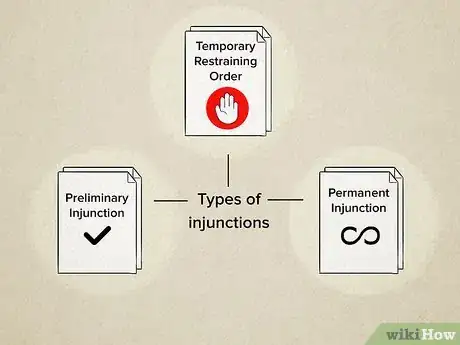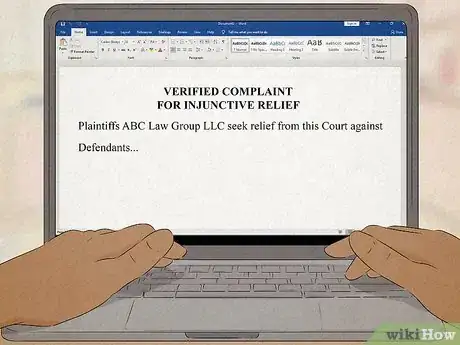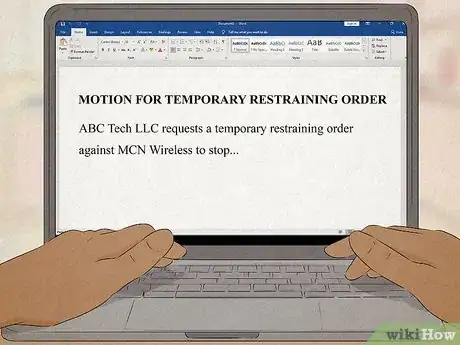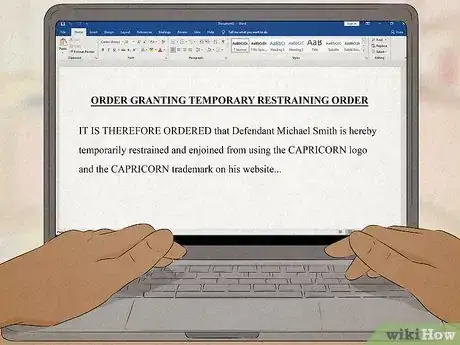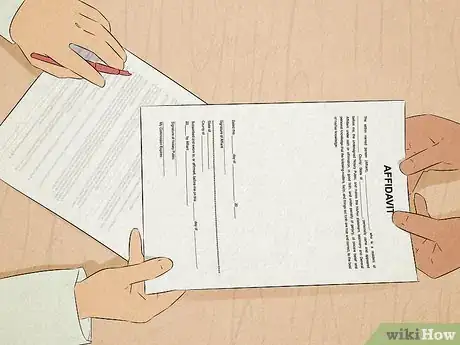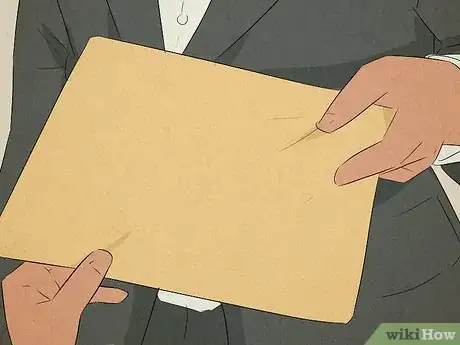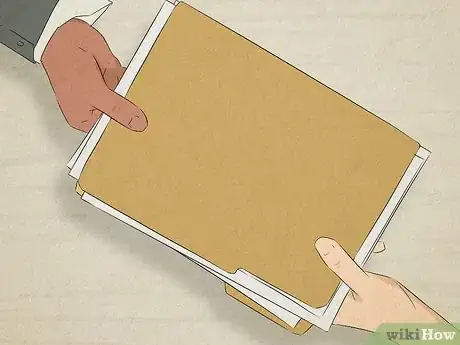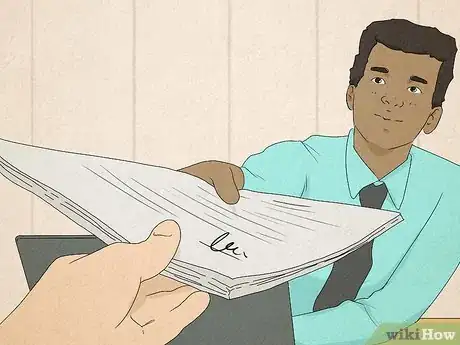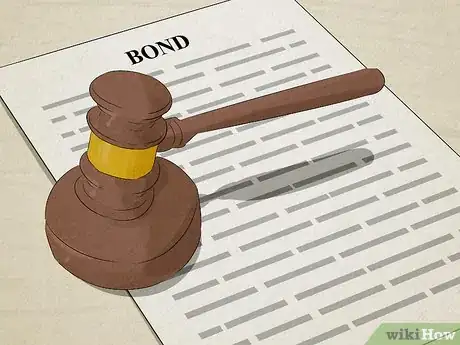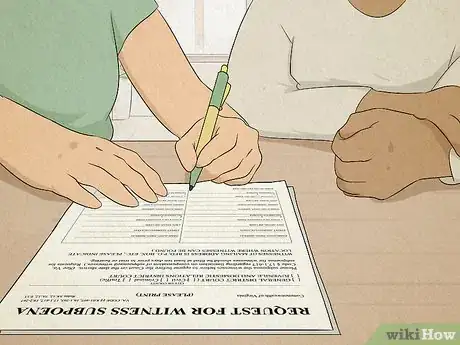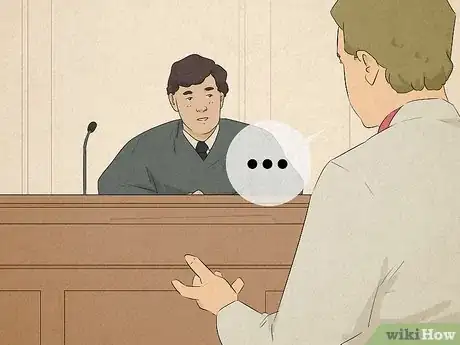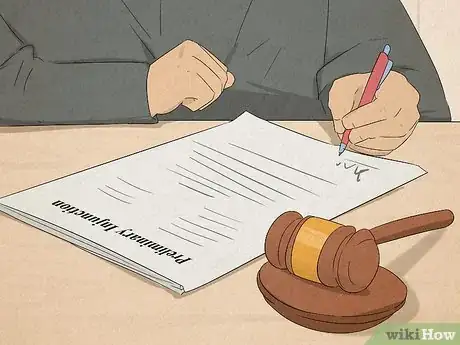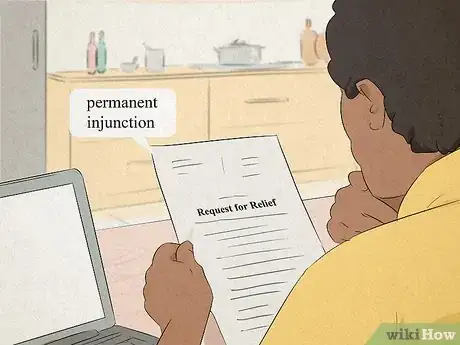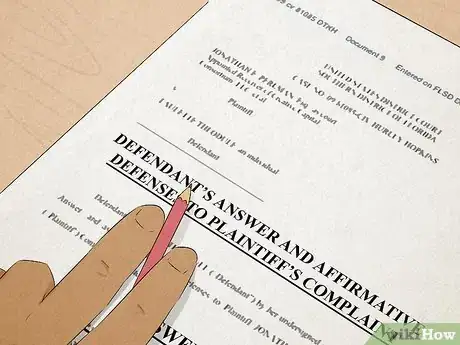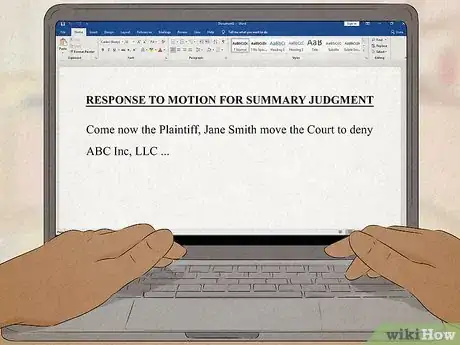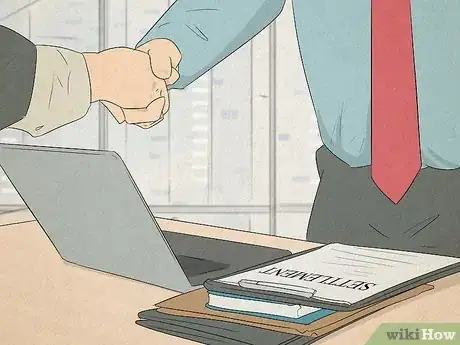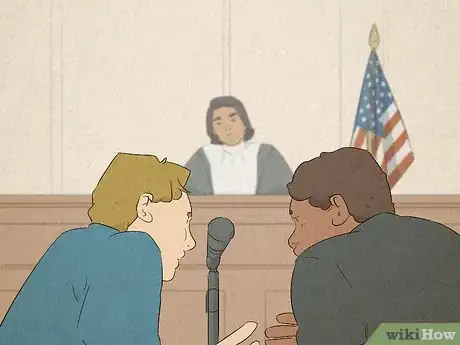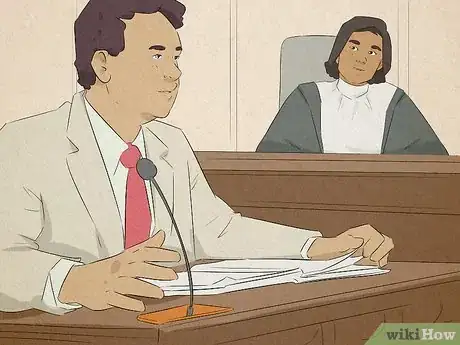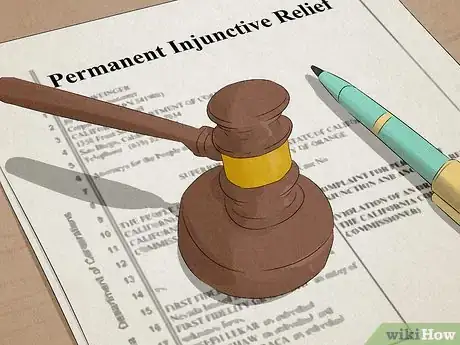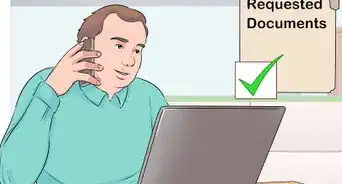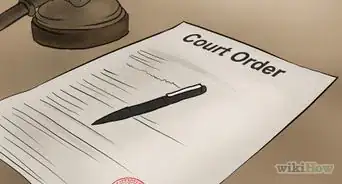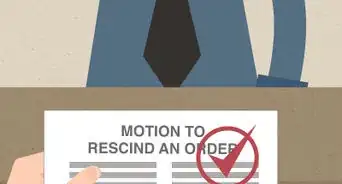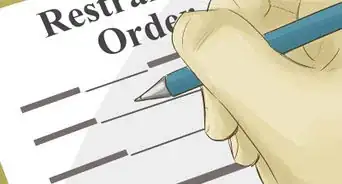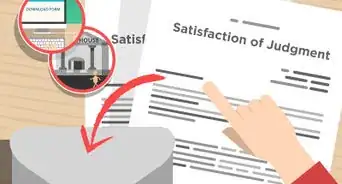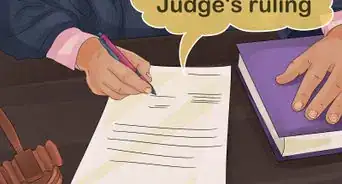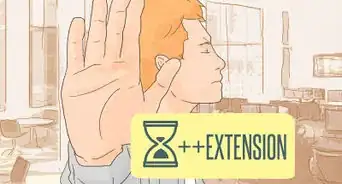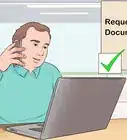This article was co-authored by Clinton M. Sandvick, JD, PhD. Clinton M. Sandvick worked as a civil litigator in California for over 7 years. He received his JD from the University of Wisconsin-Madison in 1998 and his PhD in American History from the University of Oregon in 2013.
There are 19 references cited in this article, which can be found at the bottom of the page.
wikiHow marks an article as reader-approved once it receives enough positive feedback. In this case, 80% of readers who voted found the article helpful, earning it our reader-approved status.
This article has been viewed 49,128 times.
An injunction is a court-ordered command to do something or, more often, to not do something. Typically, people bring lawsuits seeking money compensation; however, sometimes money compensation is inadequate to truly protect you. In these situations, you can seek an injunction from the court. To get an injunction, you need to file several legal documents with the court and possibly attend a hearing.
Note: If you are seeking a restraining order for harassment or domestic violence, the process is different. Courts have established specific procedures for getting restraining orders in these cases. See Get a Protective Order for more information.
Steps
Analyzing Whether an Injunction is Appropriate
-
1Identify the different kinds of injunctions. There are three different kinds of injunctions, and you should understand them before you file for an injunction with the court. Each injunction commands the defendant not to do something, but they last for different amounts of time:
- Temporary Restraining Order. You can get this injunction on an emergency basis, and it is appropriate if you face an immediate threat of injury. A temporary restraining order (TRO) can be issued “ex parte,” which means without hearing from the defendant. TROs last only a limited amount of time, typically 10-14 days, though they can sometimes be extended.[1]
- Preliminary Injunction. This injunction is also temporary, but it lasts longer than a TRO. Typically, a preliminary injunction will last for the duration of trial, or at least until the lawsuit is resolved. A preliminary injunction can turn into a permanent injunction if you win your lawsuit.
- Permanent Injunction. This injunction permanently bars the defendant from doing something. If the defendant violates the injunction, then you can sue for “contempt.”
-
2Consider whether you face irreparable harm. You can only get an injunction if you face irreparable harm without one. Generally, this means that money couldn’t compensate you for your injury. Common examples include:
- You suffer a loss that can’t be replaced. For example, someone could be threatening to knock down a building. To prevent the demolition of a building or destruction of other property, you can seek an injunction.[2]
- The injury is difficult to calculate in monetary terms. For example, your business might suffer harm to its reputation if someone is allowed to sell counterfeit goods or use your trademark. In this situation, an injunction may be appropriate because the court cannot easily calculate the damage to your reputation.
- You have to file multiple lawsuits. For example, if someone repeatedly trespasses on your property, then you would have to file individual lawsuits for each trespass. A court might grant an injunction since filing multiple suits is not realistic.[3]
Advertisement -
3Analyze other factors of your case. It’s not enough that you face irreparable harm in order to get an injunction. You generally also have to convince the judge of the following before he or she will issue an injunction:
- Likelihood of success in your lawsuit. To get a TRO or a preliminary injunction, you need to prove to the judge that you are likely to succeed in your lawsuit.
- Balance of harms. The judge will also balance the harm to you of not issuing the injunction against the harm of issuing the injunction on the defendant.
- Public interest. The court will also consider the public interest, which can take many forms: protecting intellectual property rights, protecting the public health and safety, as well as the preservation of business interests.[4]
-
4Meet with an attorney. Before filing for an injunction, you would benefit from meeting with an attorney to discuss your case. Your attorney can advise you whether to seek an injunction and which one. To find a qualified attorney, contact your local or state bar association.
- Because getting an injunction is complicated, you should think about hiring the attorney to represent you. At your consultation, ask how much the attorney charges.
- Also discuss whether you should seek a TRO in addition to a preliminary injunction. A temporary restraining order is a drastic remedy, and you should seek one only if you feel that it is absolutely necessary in order to maintain the status quo before you have a hearing on a preliminary injunction.
Seeking a Federal Temporary Injunction
-
1Draft a verified complaint. In order to get a TRO or a preliminary injunction in federal court, you have to file a verified complaint or affidavit. Your complaint should explain the dispute to the court. To draft a complaint, do the following:[5]
- Format the complaint as a legal pleading. Court documents look a certain way. This includes inserting the caption information: the name of the court, the names of the parties (you and the defendant), and the case number.
- Title the complaint: “Verified Complaint for Injunctive Relief.”
- Give the court the factual background of the dispute. Identify yourself and the defendant—where you live and that both are over the age of 18. If either you or the defendant is a corporation, then state where you are incorporated and the location of your principal place of business.
- State your legal theories. For example, someone might be using your trademark without your permission. Accordingly, you could sue for “trademark infringement.” You might sue under multiple theories. In this case, you would list them as “Count One—Trademark Infringement,” “Count Two—Embezzlement,” etc.
- Request relief. If you are suing for a permanent injunction, then be sure to ask for the injunction as your relief.
- Sign under penalty of perjury. You need to verify, under penalty of perjury of the laws of your state, that the factual statements made in the complaint are true and correct.
-
2Create a motion for an injunction. You have to file a “motion” along with your complaint in order to request your temporary restraining order and/or your preliminary injunction. You can set up the motion in the same way that you set up your complaint: the same caption at the top, the same formatting, etc.
- Title your motion “Motion for Temporary Restraining Order.” If you want both a TRO and a preliminary injunction, then title it “Motion for Temporary Restraining Order and Preliminary Injunction.”[6] If you want both, then it’s best to apply for both at the same time.
- Identify the parties.
- State the rule of civil procedure that gives the judge power to hear the case. In federal court, it is Rule 65.
- Provide the factual background of the dispute. Look at your complaint.
- Explain why you are entitled to a TRO by going through the four factors most courts look at: irreparable harm, likelihood of winning the lawsuit, balance of harms, and public interest. Explain how you satisfy each factor.
- Certify that you have notified the defendant. Although the judge will grant a TRO without a hearing, you still need to notify the defendant ahead of time.
-
3Write a proposed order. You probably also need to give the judge a proposed order to sign. This proposed order will become the temporary injunction should the judge decide to grant you one. You should find the federal rules of civil procedure, which should outline what you must include in the order.[7] You will probably have to include the following:
- The title: “Order Granting Temporary Restraining Order.” If you applied for both a TRO and a preliminary injunction, then title your proposed order: “Order Granting Temporary Restraining Order and Order to Show Cause as to Why a Preliminary Injunction Should Not Issue.”[8]
- The reason why the injunction is issued. Include a discussion of all of the factors your court considers: irreparable injury you will suffer, likelihood of success at trial, balance of hardships, and public interest.
- The person or entities that will be restrained.
- What acts are restrained. Don’t identify the acts too broadly. For example, if the defendant is illegally using your trademark, don’t write “Defendant Michael Smith shall cease doing business.” That is much too broad. Instead, you should be more specific: “IT IS THEREFORE ORDERED that Defendant Michael Smith is hereby temporarily restrained and enjoined from using the CAPRICORN logo and the CAPRICORN trademark on his website.” List all the acts you want the defendant prohibited from doing.
- The date and hour the order is issued. For example, “IT IS SO ORDERED, this 25th day of May 2016, at 3:00 p.m.”
- The date the order expires. For example, the expiration for a TRO could read: “This order SHALL remain in full force and effect through the earlier of the expiration of ten (10) days or a hearing on a preliminary injunction. The case is set for a hearing on a preliminary injunction on June 1, 2016.” You can include a blank line for the date, so that you can fill it in later.
- The date for the hearing on a preliminary injunction.
- Lines for the date and the judge’s signature.
-
4Get affidavits from potential witnesses. The judge probably will not hold a hearing on your application for a temporary restraining order. Accordingly, you should present evidence in the form of a sworn affidavit from witnesses who have relevant information.
- For example, if someone saw the defendant selling goods with your trademark, then you can have the witness write up an affidavit explaining when and where they saw the goods.
- Attach as exhibits any documents that would help your case.[9] For example, you could print out copies of the defendant’s website showing that your trademark has been illegally used.
- See Write an Affidavit for more information.
-
5Give notice to the defendant. Because of the emergency nature of TROs, you don’t need to give much notice, but courts require some. In federal court, you can give same-day notice.[10]
- Sometimes giving notice isn’t possible, but you have to certify that you have tried. Generally, you should try to call, email, fax, and use special delivery to reach the defendant. The more methods you use the better.
- In some situations you don’t need to contact the defendant. For example, sometimes providing notice will be counterproductive, since it might spur the defendant to destroy the property or leave the state. If you think this is your situation, then you must give the judge specific facts in your motion and order explaining why you didn’t provide notice.
-
6File your paperwork with the court. Gather your verified complaint, motion, order, and supporting affidavits. Make several copies. You will need to file the originals with the court clerk.
- Tell the clerk you are applying for a TRO or preliminary injunction. You will probably have to file the complaint first and attach a copy of the complaint to the motion for the injunction.
- You will have to pay a filing fee in order to file your lawsuit. You also will have to pay a filing fee to apply for the injunction.[11] The amount will differ depending on the court. Call the clerk ahead of time to find out the amount and acceptable methods of payment.
-
7Pick up the signed order. If the judge grants the TRO, then he or she should sign the order. You should be able to pick it up from the court clerk. When you file, ask what time you should return to see if the judge has granted the injunction.
-
8Get a bond. In federal court, a bond is required.[12] The purpose of the bond is to protect the defendant in case the restraining order was improperly given.
- In some courts, you can post security directly with the court, often in the form of cash.
- In other courts, you will need to visit the bondsman, who may be located in the courthouse. Alternately, the court might publish a list of surety companies you can contact to obtain a bond.
- You will have to fill out a bond application and probably provide financial statements. You also will have to attach a copy of the restraining order to the application.
- Once you get the bond, you will have to post it before the TRO will go into effect. Check with your court clerk for the procedures.
-
9Serve the TRO on the defendant. You have to give the defendant notice of any temporary restraining order since he or she did not attend a hearing and may not have received notice that you were applying for it.
- Generally, you can coordinate with the federal marshals to have the TRO served on the defendant.
- Take your signed order as well as information about the defendant’s address to the sheriff’s office. You may also have to provide the marshal with a physical description of the defendant so that the server can identify him or her.
Attending a Hearing for a Preliminary Injunction
-
1Subpoena witnesses. The main difference between getting a TRO and getting a preliminary injunction is that the judge will hold a hearing for a preliminary injunction. At the hearing, the judge may take testimony from live witnesses.[13] For this reason, you should make sure you have witnesses available to testify.
- If you are not sure that your witnesses will show up to testify, then you can serve the witness with a “subpoena.” This is a legal command to appear in court at a certain date and time to offer testimony.
- You can typically get blank subpoena forms from the court clerk. Once you have completed the form, you must serve it on the witness.
-
2Read the defendant’s response. The defendant should respond in writing to explain why the preliminary injunction is not appropriate. You should be served with a copy of the motion. If you have an attorney, then the attorney will probably be served with the motion.
- Take time to read it carefully so that you understand the arguments the defendant is making.
- Typically, he or she will focus on the four factors—irreparable harm, likelihood of success, balance of harms, and public interest.[14]
-
3Answer the judge’s questions. Each judge will run a hearing on a preliminary injunction a little differently. The judge will probably ask you questions. You may be able to ask your witnesses questions, and the defendant can cross-examine them.
-
4Receive the preliminary injunction. The preliminary injunction is temporary and lasts until it is dissolved, usually because the case has ended. If you win your trial, then the judge will probably give you a permanent injunction.[15]
Getting a Permanent Injunction
-
1Check your complaint to make sure your request for relief includes a permanent injunction. Permanent injunctions are issued by judges as final rulings in cases. Therefore, in order to receive a permanent injunction, you must ask for one in your complaint.
- Your "Prayer for Relief" section in your complaint should have a paragraph that reads: "Enter a permanent injunction to prevent future violations of the law by defendant."[16]
-
2Read the defendant's response to your complaint. After preliminary injunctions or TROs have been settled in your case, you or the defendant may want to continue with the litigation. If so, the defendant will have to respond to the original allegations in your complaint. Most commonly, the defendant will do this by filing a responsive pleading called an answer. The answer will respond to each of your allegations by either admitting or denying them. In addition, the defendant will lay out all of the defenses he or she believes will help their case.[17]
- Read the answer carefully, with your lawyer, as it will give you insight to how the defendant is going to defend the case. This information will help you determine how to proceed.
-
3Participate in Formal Discovery. Discovery gives you an opportunity to exchange information with the defendant in order to prepare for trial. During discovery you will be able to collect facts, interview witnesses, exchange documents, learn what the other side is going to say at trial, and determine how strong your case is. To achieve these goals you will use the following tools:[18]
- Depositions, which are in-person interviews with witnesses and parties conducted under oath. The answers you receive can be used in court.
- Interrogatories, which are written questions posed to witnesses and parties. The recipient must answer the questions under oath and the answers can be used in court.
- Requests for documents, which are written requests for records you would not otherwise be able to get your hands on. For example, you might request access to building blueprints, property surveys, emails, and text messages.
- Requests for admission, which are written statements the defendant will have to admit or deny. These statements help limit what needs to be heard during trial.
-
4Defeat a Motion for Summary Judgment. As soon as discovery concludes, the defendant will likely try to end the litigation and have the judge rule in his or her favor. To be successful, the defendant will have to prove there is no genuine dispute of material facts and they are entitled to judgement as a matter of law. In other words, the defendant will have to persuade the the court that, even if every factual assumption was made in your favor, you would still lose the case.
- To defend against this motion, you will file a responsive motion of your own. You need to include evidence and affidavits that tend to prove factual disputes do exist and that they need to be handled at trial.[19]
-
5Attempt to settle. If your case gets past the summary judgment stage, you might consider settling. Trial is time-consuming and financially draining. It is usually in both parties' interest to avoid trial. Start with informal discussions between the parties. Sit down with the defendant and discuss possible solutions.
- If an agreement cannot be reached, ask to move toward mediation. During mediation, a neutral third party will sit with you and the defendant to help. The mediator will try to find common ground and unique ways to structure agreements that you might not have though of before. Mediators will not inject their own opinions and will not take sides.
- As a last resort, you might agree to non-binding arbitration. During arbitration, a judge-like third party will hear both parties present evidence. At the end, the arbitrator will take sides and draft an opinion stating who he or she thought should win.
-
6Attend the final pretrial hearing. When a settlement cannot be reached, you will attend a final pretrial hearing to set the trial schedule. The trial schedule will be followed closely and the judge will rarely allow you to deviate from it. Therefore, it is important that you bring up every issue you want discussed at trial during this hearing.[20]
-
7Go to trial. At trial, both parties will present evidence in an attempt to persuade the judge to rule in their favor. When you present evidence, you will do so through physical exhibits and witness testimony. In addition, to evidence required to prove the underlying case, be sure you include evidence that shows the judge why you need a permanent injunction.
- This evidence should touch on three of the four main factors of an injunction (i.e., irreparable harm, balance of harms, and the public interest). Because you are asking for a permanent injunction, the court will not pay much attention to the likelihood of success at trial (because a permanent injunction comes into play after the trial as a final ruling).
-
8Get permanent injunctive relief. When the trial concludes, the judge will issue their final order. If you succeed, the final order may include a permanent injunction against the defendant. If this happens, the defendant will have to stop doing whatever they were doing permanently. If the defendant ever runs afoul of the permanent injunction, you can ask a court or law enforcement agency to step in.
References
- ↑ https://www.law.cornell.edu/rules/frcp/rule_65
- ↑ https://scholar.google.com/scholar_case?case=8416609368890063382&q=408+F.Supp.+1323&hl=en&as_sdt=400003
- ↑ https://scholar.google.com/scholar_case?case=1755133886132386207&q=439+A.2d+357&hl=en&as_sdt=4,7
- ↑ Patterson, Handling the Business Emergency: Temporary Restraining Orders and Preliminary Injunctions, 52-53
- ↑ http://www.fec.gov/law/litigation/rnc_rnc_complaint.pdf
- ↑ https://epic.org/privacy/ftc/google/TRO-Motion-final.pdf
- ↑ https://www.law.cornell.edu/rules/frcp/rule_65
- ↑ https://www.eff.org/document/order-granting-temporary-restraining-order
- ↑ https://www.nycourts.gov/LegacyPDFS/courts/1jd/supctmanh/Self-Rep%20Forms/How%20to%20OSC.pdf
- ↑ Patterson, Handling the Business Emergency: Temporary Restraining Orders and Preliminary Injunctions, 22
- ↑ https://www.nycourts.gov/LegacyPDFS/courts/1jd/supctmanh/Self-Rep%20Forms/How%20to%20OSC.pdf
- ↑ https://jenner.com/system/assets/assets/5511/original/Temporary_20Restraining_20Orders_20and_20Preliminary_20Injunctions_2011.pdf?1323113835
- ↑ http://www.bzbm.com/wp-content/uploads/2013/07/Stop-That-Right-Now-ABA-2010.pdf
- ↑ https://epic.org/free_speech/censorware/PI_opp.pdf
- ↑ http://law.freeadvice.com/litigation/legal_remedies/temporary-restraining-order.htm
- ↑ https://www.ftc.gov/system/files/documents/cases/160414mercolacmpt.pdf
- ↑ http://www.wawd.uscourts.gov/sites/wawd/files/ProSeManual4_8_2013wforms.pdf
- ↑ http://www.courts.ca.gov/1093.htm
- ↑ https://www.law.cornell.edu/wex/summary_judgment
- ↑ http://www.wawd.uscourts.gov/sites/wawd/files/ProSeManual4_8_2013wforms.pdf
About This Article
To get an injunction, start by drafting several legal documents, including a complaint explaining your dispute, a motion asking for the injunction, and a proposed order that the judge can sign if they grant it. You should also try to get sworn statements from witnesses who can support your side of the story. When you have everything together, notify the person you want the injunction against, then file your documents with the court and pay the filing fee. Additionally, ask the court clerk when you should return to find out if the judge has granted your injunction. For more information from our Legal co-author, including how to decide what kind of injunction you should apply for, read on!
